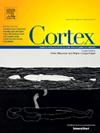Outbalanced: The cross-cortical effects of prefrontal neuromodulation in posterior parietal cortex
IF 3.2
2区 心理学
Q1 BEHAVIORAL SCIENCES
引用次数: 0
Abstract
Cognitive phenomena such as the Spatial–Numerical Association of Response Codes (SNARC) effect can arise in the fronto-parietal cortical network. Prior neuromodulation studies with cathodal transcranial direct current stimulation (tDCS) over the left prefrontal cortex (PFC) reduced the SNARC effect. Prior neuroimaging studies with functional near-infrared spectroscopy (fNIRS), however, showed signatures of the SNARC effect in the posterior parietal cortex (PPC). In this study, we investigated the distant neural effect of prefrontal neuromodulation on hemodynamic activity in the parietal cortex by combining cathodal tDCS with fNIRS. The SNARC effect and the numerical distance effect (NDE) were assessed in an event-related cross-over design (N = 45), when cathodal tDCS of 1 mA at the left PFC was applied simultaneously during the measurement of fNIRS covering the bilateral PPC. At the behavioral level, prefrontal tDCS did not significantly reduce the SNARC effect, indicating that the replication failed here. Crucially, at the neuronal level, prefrontal tDCS reduced left parietal activation associated with the SNARC effect but not with the NDE. This neuronal effect of tDCS in a remote site was shown in preregistered primary region-of-interest analyses and in secondary all-channel analyses. The results showed how the combination of neuromodulation and neuroimaging shed light on the fronto-parietal network responsible for numerical cognition, and how fNIRS can assess the distant neural effects of cathodal tDCS.
平衡:后顶叶皮层前额叶神经调节的跨皮质效应
反应码的空间-数值关联效应(SNARC)等认知现象可在额顶叶皮质网络中产生。先前在左侧前额叶皮质(PFC)上进行的经颅直流电刺激(tDCS)神经调节研究减少了SNARC效应。然而,先前使用功能性近红外光谱(fNIRS)进行的神经影像学研究显示,后顶叶皮层(PPC)存在SNARC效应。在这项研究中,我们通过结合阴极tDCS和fNIRS研究了前额叶神经调节对顶叶皮层血流动力学活动的远端神经效应。在事件相关的交叉设计(N = 45)中,当在测量覆盖双侧PPC的fNIRS时,在左侧PFC同时施加1ma的阴极tDCS时,评估SNARC效应和数值距离效应(NDE)。在行为水平上,前额叶tDCS并未显著降低SNARC效应,表明此复制失败。至关重要的是,在神经元水平上,前额叶tDCS减少了与SNARC效应相关的左顶叶激活,但与濒死体验无关。在预先登记的主要感兴趣区域分析和次要全通道分析中显示了tDCS在远程部位的神经元效应。结果显示,神经调节和神经成像的结合如何揭示了负责数字认知的额顶叶网络,以及fNIRS如何评估阴极tDCS的远端神经效应。
本文章由计算机程序翻译,如有差异,请以英文原文为准。
求助全文
约1分钟内获得全文
求助全文
来源期刊

Cortex
医学-行为科学
CiteScore
7.00
自引率
5.60%
发文量
250
审稿时长
74 days
期刊介绍:
CORTEX is an international journal devoted to the study of cognition and of the relationship between the nervous system and mental processes, particularly as these are reflected in the behaviour of patients with acquired brain lesions, normal volunteers, children with typical and atypical development, and in the activation of brain regions and systems as recorded by functional neuroimaging techniques. It was founded in 1964 by Ennio De Renzi.
 求助内容:
求助内容: 应助结果提醒方式:
应助结果提醒方式:


